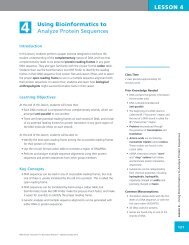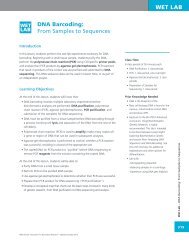Historical Case Studies and Student Guiding Questions - Northwest ...
Historical Case Studies and Student Guiding Questions - Northwest ...
Historical Case Studies and Student Guiding Questions - Northwest ...
Create successful ePaper yourself
Turn your PDF publications into a flip-book with our unique Google optimized e-Paper software.
STUDENT HANDOUT 1.1bThe Havasupai Indians<strong>Case</strong> Study B: The Havasupai IndiansThe Havasupai Indian tribe lives in the state of Arizona, deep in the Gr<strong>and</strong> Canyon, relatively isolated from the rest of U.S.society. The tribe’s language, called Pai, is spoken by all of its approximately 639 members. Only a few members of thetribe have graduated from an English-speaking high school. Unemployment is very high in the community <strong>and</strong> income ismostly dependent on seasonal tourism. To access medical facilities, tribal members must either hike for miles on a steeptrail or leave the canyon via horse or helicopter.In the 1960s, the tribe began seeing a very high incidence of Type II Diabetes among their members. As a result, manyof the members suffered poor health, <strong>and</strong> some needed to have limbs amputated to treat the disease. In 1989, membersof the tribe contacted researchers at Arizona State University (ASU) to figure out how to control the disease <strong>and</strong> treatmembers of the tribe.Researchers had already established that a neighboring tribe, the Pima Indians, had a genetic link to diabetes. Theresearchers sought to investigate whether the Havasupai had a similar genetic link to the condition. The researchers fromASU received money in 1990 from the university to carry out the investigation. From 1990 to 1994, many tribe memberswere recruited for the study. To participate, the members signed a general consent form that stated the research theywould be participating in would “study the causes of behavioral/medical disorders.” The Havasupai research subjectsprovided blood samples. In turn, the tribe received limited medical care.In 1991, the research study yielded a paper that showed that there was no direct evidence to link the tribe’s genes to diabetes.After the initial study was conducted, researchers continued to use the Havasupai’s blood for research on schizophrenia,inbreeding, <strong>and</strong> patterns of human migration. The migration research is notable because the Havasupai never agreedto the use of tribal members’ blood for research that might contradict the tribe’s traditional stories of origin. The tribebecame aware of this additional research in 2003, when one of the tribe members was invited to a talk at ASU where adoctoral student presented information from a study that used Havasupai blood samples. Carletta Tilousi, a tribe memberwho attended the ASU presentation, remarked, “I’m not against scientific research. I just want it to be done right. Theyused our blood for all these studies, people got degrees <strong>and</strong> grants, <strong>and</strong> they never asked our permission.”HANDOUTThe tribe members who contributed blood samples for research purposes did not know that their blood was being usedto study other conditions in addition to diabetes. The Havasupai tribe sued ASU <strong>and</strong> received $700,000, several forms ofadditional support <strong>and</strong> resources for the tribe, <strong>and</strong> in 2010, the return of all their remaining blood samples.This summary is based on a true story. Please see the Sources section for reference information.Contributed by Myra Arnone, Redmond High School, Redmond, WA.Type II Diabetes: A chronic medical condition that affects how the body metabolizes sugar (glucose).Type II Diabetes typically begins in adulthood <strong>and</strong> patients are not usually dependent on the use of insulinto control their sugar levels.Inbreeding: When closely related people within an isolated group have children together, generationafter generation.Incidence: The percentage of newly diagnosed cases of a disease in a population.Schizophrenia: A mental illness resulting in greatly impaired thinking, emotional responses, <strong>and</strong> behaviors.Stories of origin: Stories that recount how something (or a people) came into being.© <strong>Northwest</strong> Association for Biomedical Research24 | HUMANS IN RESEARCH
















